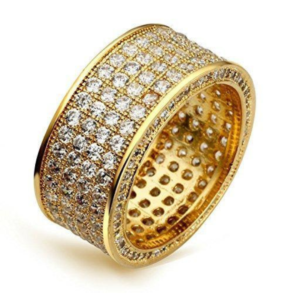STONE REPLACEMENT
Crafting & Maintaning Jewelry

The objective when stone setting is to use the minimum amount of material necessary to secure the gem. In doing so the expert must provide maximum longevity of the piece. You need only look at a simple engagement ring with stilted fine wire prongs to understand the importance of this art. We tend to take it for granted that all of the wonderful sparkles in our jewelry pieces magically stay in position. In fact, it is made possible by expert stone setting done by a specialized group of jewelers practicing a lost art.
TYPES OF STONE SETTINGS
Stone setting is generally intended to raise and dramatize a single stone, while some other types offer various numbers of gems to be viewed as a group. There are stone setting techniques with detailed handiwork that is intended to lead the eye to the featured design. In other cases, the setting work is intended to guard a fragile gem from prolonged use.
Here are a few examples of the types of stone setting used in modern jewelry:
1. PRONG SETTING

Because of its use in engagement rings, prong setting is known to almost everyone. The most typical prong setting is the traditional four or six prong configurations, which range in style from trellis designs to baskets. The elevation of prong-set stones allows light to come in from the top and the sides, and it is undoubtedly the most popular method of stone setting for individually featured gems.
When stone setting in prongs, a jeweler begins with prongs that are considerably longer than those you see in your finished product. The long prongs are then carefully cut with rotary tools to remove around 1/3 of the metal to form the base in which the gem will rest. The carefully carved seat is then shaped to match the shape of the gem that has to be placed. Once the stone is placed, the technician will use professional pliers and multiple pushing tools to wrap the prongs around the stones edges. After the prongs are snug, they are meticulously trimmed to achieve the desired shape and size.
2. BEAD SETTING

Bead setting is mainly used to display sequences of small diamonds in strands or continuous rows. Enjoying mass popularity during the late 1800’s through the early 1900’s in Georgian, Victorian, Edwardian, and Art Deco jewelry, the bead setting lost its charm soon after. Today, the resurrection of the bead setting can be seen in nearly every piece in the jewelry market.
Obtaining its origin from beads raised with hand tools, technicians drilled holes in solid plates of metal and shaved away gold or platinum to form miniature beads from scratch. The monotonous stone setting that was done by old world craftsman can now be done in half the time because of the introduction of new technology which allows designers to position precise bead work throughout a jewelry piece with greater ease.
3. PAVE SETTING

Pave Setting is typically a type of bead setting. The difference in this is the arrangement of stones. Diamonds are set in fields rather than rows or strands. Pave set diamonds usually cover a broad expanse and share beads to create a diamond encrusted appearance. The bold diamond surfaces created by pave setting are beautiful and dreamed of in fine jewelry
4. CHANNEL SETTING

With clearly defined edges and clean, flowing lines, the walls of channel set stones provide technicians with prominent borders and edges.
Small stones set side by side are poised in walls slotted in strips of gold and platinum. Either the same in size or gradually tapering, strands of channel set stones can be set in rows, or ribbon throughout a piece of fine jewelry.
The channel setting is brought to life when a jeweler uses a rotary cutter to create a ditch in precious metal that is grooved to the size of a gem. Once the setting wall is prepared, the stone is carefully placed into its seat. Using a precise impact hammer, precious metal is carefully chased over the ribbon to secure the stone at the wanted angle.
5. FLUSH SETTING

Flush setting, as the name suggests, enables jewelers to create jewelry featuring stones that lie flush in the surrounding metal. This type of stone setting is mostly used to set smaller stones to create a spangled look. Flush set stones can give the effect of scattered glitter to flat or domed areas.
After drilling a hole into gold or platinum, the stone setter uses a hand- held, flexible shaft make space to accommodate the jewels. With stones positioned flush, the metal surface is gently manipulated with a chasing tool to lock them in place. Once securely in place, the edge of the work is trimmed and neatly burnished with a bright edge to accentuate the glistening gem.
Own a beloved jewelry piece that lost its stone, or is begging for a revamp? Or an idea brewing in your head about a bespoke stone encrusted piece you’ve wanted to bring to life in forever? Bring it over to Gold Fixers and let our expert technicians bring it right back to life!



